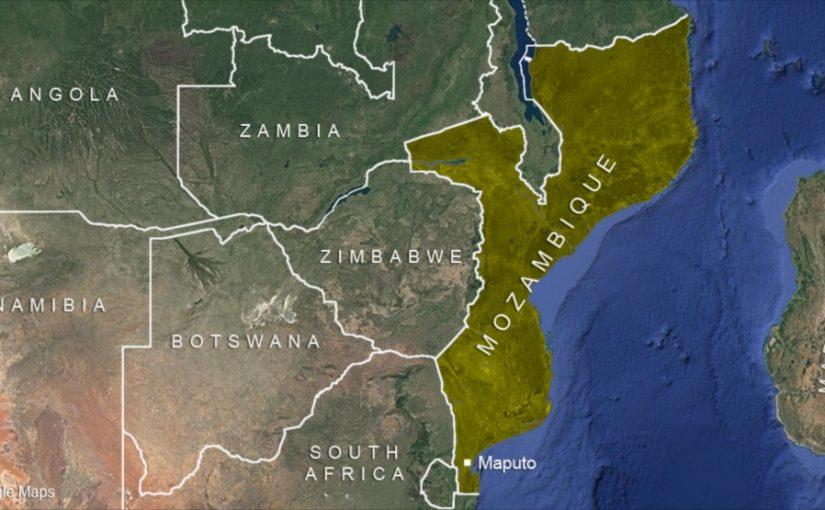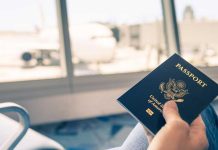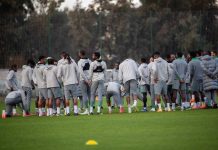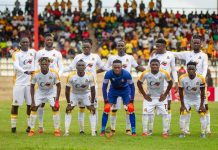Africa-Press – Mozambique. In this issue
Gas
Covid-19
Cabo Delgado
Other news
La Nina – a bit more rain in south & centre
One man controls Nyusi’s ‘1 district, 1 hospital’
The ever optimistic Minister of Mineral Resources and Energy, Max Tonela, said that there could be an imminent decision to restart work on gas. “The outlook is that before the end of the year we are going to have all the conditions for us to sit down and decide to resume the project”. He was speaking 24 November following a meeting between President Filipe Nyusi and Hirotatsu Fujiwara, the vice-president of Mitsui, which owns 20% of Area 1 (closest to the coast, operated by TotalEnergies). (TVM 25 Nov)
But Galp does not agree, “Galp really feels that we need a sustainable and lasting peace, if we are invest billions of dollars in the gas ventures,” Andy Brown, president of Galp, said just the day before. “It is really important that we have lasting peace and well-being. If we have this, I think we will be able to continue to invest a lot of money, which will promote employment and benefits for Mozambique,” he stressed. (LUSA 23 Nov) But “a sustainable and lasting peace” will not be achieved by the end of the year. Galp owns 10% of Area 4, further off-shore, and run by ExxonMobil and ENI.
Tonela said on Thursday (25 Nov) that the oil consortiums operating in the Rovuma basin are negotiating forms of partnership to reduce costs and maximise earnings. This is “not aimed at buying stakes, it is aimed at identifying areas to partner in order to minimise or reduce the overall costs of these investments.” (LUSA 26 Nov)
Gas is an global business. Area 1 lead is French, and partners are Japanese (Mitsui) plus state companies from India, Thailand, and Mozambique. Area 4 is operated by a joint venture of US, Italian and Chinese companies which hold 70%, and 10% each from Galp and South Korean and Mozambican state companies.
Galp is the also largest distributor of LPG cooking gas in Mozambique.
Galp Mozambique chair Paulo Varela on 24 November opened a $12 mn upgrade of its cooking gas filling factory in Matola, which he said would end shortages of cooking gas. Filling rate has been increased by 25% to 1,200 11-kilogramme gas bottles an hour. Hopefully the checks of also been increased, as Galp was caught in August selling 11 kg bottles with only 9 or 10 kg of gas. Bottled cooking gas is LPG (Liquefied petroleum gas) and in Mozambique is a mix of propane (C3H8) and butane (C4H10).
Attempts to limit gas in Mozambique are “not sensible”, IMF representative in Mozambique, Alexis Meyer-Cirkel, said in an open briefing 23 November. “I think that this discussion, preventing Mozambique from developing this wealth, disproportionately penalises a country that has not contributed to the creation of the problem and that is a poorer country,” he stressed.
“Mozambique is a country that emits very little” carbon, in proportion to its population and in comparison to other countries in the world, he added.
The IMF has always promoted gas and other big resource projects in Mozambique, but Meyer-Cirkel went on to raise some questions. He showed the slide below, predicting that in the post-Covid period African non-resource countries are recovering well, but resource countries are not. African resource counties are predicted to lose 2.9% of per capital GDP between 2019 and 2022, while non-resource countries are expected to gain 3.8% of GDP – a huge difference.
The reason, he explained, is that non-resource countries have more diversified and flexible economies and can better respond to difficulties.
This point was underlined the next day by a presentation at the annual UEM-Wider Inclusive Growth Conference. Fernando Lichucha from Universidade Eduardo Mondlane (UEM) showed that in 1992-6, agriculture accounted for half of Mozambican GDP growth. By 1997-2001 manufacturing was also important. But by 2012-16 growth was driven by services and the extractives, with manufacturing and agriculture having a tiny role. Yet more than 70% of the population still has agriculture as their main activity.
This, in turn, drives the widening inequality. Commerce, finance, services and “other” account for 58% of all people with secondary education, and 85% of all with higher education. So widening inequality is driven by a better educated elite in the services, finance and extractive sector.
There is no support for educated people to drive growth in farming or manufacturing – exactly the point that IMF’s Meyer-Cirkel is making.
Comment:
This is one part of the resource curse. Concentration on the extractives sector means no attention is paid to manufacturing and the biggest sector of the economy, agriculture, which receive no support. The other part of the resource curse employs the oligarchs created as part of the post-Cold-War 1990-95 “Shock Therapy” to turn communists into capitalist. “Shock therapy” forced governments out of the economy, and senior party figures with access to land, resources or state contracts were targeted with the “greed is good” message. They grabbed assets but could not exploit them without turning to major western corporations. In Mozambique Raimundo Pachinuapa, liberation war leader and still a member of the ruling Frelimo Political Commission, grabbed the land of the diamond fields, then sold 75% to Gemfields to exploit them. Gas is the same – controlled by Frelimo oligarchs but passed on to transnational petroleum companies to exploit.
The $2 bn secret debt, orchestrated by Credit Suisse and Privinvest, followed this model. When the deal became public in 2016, donors, led by the IMF. substantially cut aid. The World Bank never joined, and instead increased lending to help fill the gap. And from 2019 the IMF has realised its “mistake” – it has provided $118 mn for cyclone reconstruction and $322 mn for Covid-19.
The IMF admits that concentration on extractives is bad for the economy. But the World Bank and IMF know that it is good for Mozambique’s oligarchs and especially for their foreign partners. jh
Covid-19
The new Covid Omicron variant has already led to sharp travel restrictions between Mozambique and most countries of the north. First discovered two weeks ago in Botswana and South Africa, the variant has an unusually large number of mutations, particularly affecting the spike protein. Initial indications are that it is more infectious, but not leading to more hospital admissions. WHO has labelled the variant Omicron (15th letter of the Greek alphabet and origin of the Latin letter “o”)
The rapid response is due to predictions that Omicron will cause the next global wave of Covid.
South African Covid daily cases jumped from 275 on 16 November to 2800 on 26 November – a 10-fold increase in 10 days. Daily deaths in that period jumped from 15 to 114. Two KLM planes with 600 passengers from South Africa were held at Schiphol airport, Amsterdam, while they were tested. Dutch authorities said that 61 of the 600 tested positive for Covid, and of those, 13 had the Omicron varient.
Covid cases are still falling in Mozambique, down to 32 cases and 2 deaths last week. But there are already cases of Omicron. Italy found the Omicron variant in a fully vaccinated man who returned to Italy from Mozambique a few days ago. (RaiNews 27 Nov)
But the question is whether or not Mozambique will restrict the border with South Africa. Confusion over testing caused queues lasting several days in January of this year.
So far, government response has been the opposite. Immigration Service (SENAMI) Maputo Province spokesperson Juca Bata said Wednesday (O Pais 25 Nov) said changes have been made to take a large increase in Christmas-New Year traffic at Ressano Garcia, the country’s largest and busiest land border. The usual 18 booths at the Ressano border post will increase to 29, with an increase in service personnel. Migrant miners returning from South Africa for the holiday will have a separate service. And an entire separate border post has been set up for the 800 trucks a day carrying ferrochrome from South African mines to Maputo port.
Unless government decides otherwise, the border will be closed during the national 11 pm to 4 am Covid curfew.
But without restrictions, the wave of visitors and returnees will start the next Covid wave in Mozambique.
Mozambicans arriving must be tested and foreigners must prove vaccination,
Maputo province medical chief Celestina da Conceição told STV Saturday (27 Nov). Foreigners wishing to enter the country must show proof that they have been vaccinated.
Mozambicans returning to the country will be submitted to rapid tests, or to the more thorough PCR (polymerase chain reaction) tests. For citizens who take PCR tests at the border “we have the capacity to follow up those who tested positive, regardless of what provinces they come from. We have a data base that we send to all delegations in the country to follow up these cases”. She added that Maputo province has the capacity to carry out its own tests, with the capacity for carrying out 2,000 tests a day”, she said.
Will there be enough vaccines donated to vaccinate all adults?
Speaking on Radio Mozambique, Health Minister Armindo Tiago said he is confident that, by the end of this year, 50% of the population will have been vaccinated. The target figure is 17 million, and to date about 7 mn have received at least one dose of the vaccine.
“Despite the repeated warnings of health leaders, our failure to put vaccines into the arms of people in the developing world
is now coming back to haunt us. We were forewarned – and yet here we are,” writes Gordon Brown, former UK prime minister and now WHO ambassador. (Guardian 27 Nov https://bit.ly/3E0KBHs)
“In the absence of mass vaccination, Covid is not only spreading uninhibited among unprotected people but is mutating, with new variants emerging out of the poorest countries and now threatening to unleash themselves on even fully vaccinated people in the richest countries of the world.” Brown notes that earlier this year developed countries promised millions of does. At present the US had delivered 25% of those it promised – the highest now. The EU has delivered 19%, UK 11%, and Canada 3%. “Even as the gap between the vaccines haves of Europe and the vaccine have-nots of Africa mushroomed, the EU insisted on commandeering millions of South African-produced Johnson & Johnson one-shot vaccines and sending them out of Africa into Europe.”
“As of today, 500m unused vaccines are available across the G7. By December, the figure will rise to 600m,” Brown adds. “The alternative is too awful to contemplate; vaccines are being destroyed while lives are being lost through lack of them. According to the data research agency Covax, around 100m of western countries’ vaccines will pass their use-by dates in December and could easily go to waste. Of course, there will be issues of absorption in Africa, but the bigger problem is that too many of the vaccines gifted to the poorest countries are within 12 weeks of their ‘use-by-dates’” – not enough time to properly plan.
African “scientists sharing Omicron data were heroic. Let’s ensure they don’t regret it.
The teams in Africa who detected the new Covid genome moved quickly. Their actions should not result in economic loss,” writes Jeffrey Barrett, who leads the Covid-19 genomics initiative at the Wellcome Sanger Institute, which leads the rapid sharing of 1 million Covid sequences.(London Sunday Observer 28 Nov https://bit.ly/3CUMZOI)
“On 23 November, scientists in Botswana uploaded 99 Sars-CoV-2 genome sequences to this database. Like most submissions that day, nearly all the sequences were the dominant Delta variant. But three of them looked different from anything seen before.
“Later the same day, an independent team in South Africa uploaded seven nearly identical genomes. These teams noticed that the new variant contained an eye-watering number of mutations in the part of the virus’s genome that encodes the spike protein, which it uses to infect human cells.”
“While these scientists worked around the clock, the fact that they had shared the sequences with the world as part of their routine process, before they even knew what they were, meant that other scientists, thousands of miles away, could study them as well. … The mutations in the new variant also alarmed the international scientists. … Once additional evidence gathered by the local teams in South Africa had been presented, the World Health Organization (WHO) made it the fifth variant of concern, Omicron. Just 72 hours had passed since the original discovery.
“The scientists who sounded the alarm because they are committed to the moral imperative of rapid data sharing knew that in the midst of the pandemic it would have consequences. Tulio de Oliveira, one of the leaders of the South African genomics team, announcing the variant, tweeted: ‘The world should provide support to South Africa and Africa and not discriminate or isolate it! By protecting and supporting it, we will protect the world!’”
South Africa cannot get enough Covid-19 vaccine, and less than 25% of South Africans are fully vaccinated. “It would be a disaster if the global response to this heroically open science sent the message that the reward for such bravery is isolation,” writes Barrett.
Cabo Delgado+
As predicted, and following Frelimo’s model after the Portuguese 1970 Operation Gordian Knot (see this newsletter last week https://bit.ly/Moz-580), the guerrillas are moving away from the heavy military push by the Rwandans and have gone to another province, in this case Niassa.
Three attacks have been reported in the past week Mecula, the Niassa district that borders both Tanzania and Mueda in Cabo Delgado. Parts of Niassa still have very low population resulting from the slave trade 200 years ago, and the insurgents have established bases in remote parts of Mecula.
A vehicle carrying salaries for the staff of the Niassa National Reserve was attacked and four police officers accompanying the money were killed. (Cata de Mocambique 29 Nov) Also on Thursday in Gomba village, insurgents attacked and burned a vehicle of the Niassa National Reserve.
On Saturday (27 Nov) the police post in the village of Naulala was attacked and a police officer killed. Insurgents took medicines from the health post and burned the house of village administrator. (MediaFax 29 Nov)
Insurgents attacked a Makonde initiation ceremony,
killing two and kidnapping two, in Chitolo village in the hotly contested area of Chai, Macomia district, Cabo Delgado, early Monday morning (29 Nov). People who had only recently returned, fled the village anew. “We were preparing for a traditional ceremony, which involves taking children to the bush, when we heard shots nearby and suddenly hooded men arrived and surrounded the village,” a person from the village told Lusa (29 Nov).
A dozen independent police special forces companies have been formed to protect district capitals, President Filipe Nyusi announced in the northern city of Nampula on Friday (Nov 26), speaking at the final parade of the Mocimboa da Praia independent company. They have been trained to handle complex security situations, such as the insurgent raids that have plagued much of the northern province of Cabo Delgado since October 2017. (AIM 29 Nov)
Five of the independent companies will go to Mocimboa da Praia, Palma, Nangade, Muidumbe and Quissanga, areas severely affected by the insurency in Cabo Delgado. Two will go to Mecula and Marrupa in Niassa, clearly under threat. And five will go to Memba and Moma in Nampula; Pebane and Gurue in Zambezia; and Inhassoro in Inhambane.
“The terrorist threat and other challenges”, he continued, “are leading us to strategic and operational re-invention, ever more adapted to concrete realities”.
“In our current concept, the independent company does not have a barracks”, said Nyusi. “Its theatre of operation is everywhere where there is crime. The performance of each district unit, will be judged by the absence of crime or by the high rate of clearing up crimes.”
Although they are independent units “they must maintain the greatest level of coordination with other defence and security forces on the grounds in order to avoid duplication of efforts. They must maintain a permanent state of readiness, and will not be static, since their mission demands greater dynamism”. Nyusi declared.
It is not clear how these units differ from the paramilitary riot police (UIR), which had been fighting the war.
Relations between host and displaced communities are negative and seem to be deteriorating, both groups told a survey by UNHCR’s Cabo Delgado Protection Cluster, published 18 November. https://bit.ly/Moz-Palma-Protect The survey and focus group interviews were done in Quitunda, Maganja and Mondlane villages, just south of Palma, which have a mix of people having fled Palma and local people, many of who also fled but have now returned.
“Tensions between the host and IDP [internally displaced people] community … are linked to the lack of access to essential services, basic assistance, and limited natural resources. During the assessment, host community focus group participants openly stated that they want the IDP community to return to their place of origin.” The report adds: “For most, the intention of displaced communities is to return.”
Some community leaders were “said to be denying IDP children’s access to school and excluding IDP households from distribution lists. … Evidence of discrimination towards the IDP community was also mentioned in relation to service providers. IDP women recounted walking for five hours pregnant or having just delivered only to be turned away at the health centre when trying to access maternity services.”
“Both the host and IDP communities lack civil documentation. … Women in Mondlane reported being denied access to maternity services in health centres as they do not have documentation. Furthermore, since children are being delivered at home, births are not being registered, thus elevating child protection risks.”
“Access to machambas (traditional farmland for subsistence agriculture) is limited for the IDP population and thus a source of inter-community tension. Only in Mondlane had some machamba plots been provided for rural activities for IDPs with the agreement that these would be returned to the host community families once those displaced are able to return,” the report says.
“In Quitunda and Mondlane, some IDP families sleep in open air. There is tension as some shelters of the host community are unused because their owners have fled due to the conflict, however IDPs without shelter are not given permission to temporarily use these empty shelters. Construction materials are only available from the nearby forested areas, yet the quality of wood is often poor, and access limited due to checkpoints.”
Six Mahindra pickup trucks have been donated to the Mozambican police
by the UN International Organisation for Migration (IOM) to go to Ancuabe, Chiure, Metuge, Montepuez, Namuno, and Pemba districts of the Cabo Delgado, where many people have taken refuge from the fighting. Specifically, the vehicles will support the work of the Community Policing Department. An unstated aim appears to be reducing tensions between displaced and local people.
Frelimo’s distrust of the United States goes back decades. The US and NATO supported Portugal in the independence war and then in the 1980s used Renamo and apartheid South Africa to run a proxy war in Mozambique. Post-war arrogance and promoting neo-liberalism did not help. Nonetheless, the US has always coveted a base in Mozambique, preferably Nacala.
The Cabo Delgado war provides a new opportunity, with the US labelling it part of a global Islamic jihad and wanting Mozambique as a base to fight ISIS. One reason to bring in Rwanda so quickly was to side-line the US. This brought two responses.
Samantha Power, USAID Administrator on 19 November criticised the European Union for its close cooperation with the regime of Paul Kagame, who has ruled Rwanda with an iron fist since 2000. Others, up to President Biden, have criticised Kagame’s human rights record, and his murders of dissidents, including in Mozambique. (CDD 25 Nov) Many in Mozambique feel the US has no standing to speak, after its 1980s proxy war took the lives of 2 million Mozambicans.
On the other hand, the US is pushing Mozambique to take more military help, and clearly sees Rwanda as the opposition. Stephen Townsend, commander of the US Africa Command, was in Mozambique 17-18 November. “We have a meaningful partnership with Mozambique and our conversations sharpened our focus on our mutual security concerns,” Townsend said. “Our training and other engagements, such as the Joint Combined Exchange Training that happened this spring, demonstrate our partnership. We look forward to finding ways to strengthen our relationship with Mozambique in the future.”
This year there were two training programmes in which US Special Operations Forces trained Mozambican commandos and marines. US Expeditionary Sea Base USS Hershel “Woody” Williams – effectively a floating platform – visited Maputo on 15 October.
So the diplomatic tussle continues between the US on one side and France and Rwanda on the other.
The European Council approved $45 million in funding for the European Union Training Mission
in Mozambique (EUTM) in early November. The money will go to purchase non-lethal equipment for the quick reaction force units the EUTM seeks to create within the Mozambican military. In the current EUTM plan, five companies will be trained by the end of 2022 and another six at some point thereafter. (Cabo Ligado 23 Nov)
Other News
A La Nina weather event has been declared by Australia’s Bureau of Meteorology; the World Meteorological Organization (WMO) is yet to declare a La Nina but has warned one may emerge. La Nina is cooler than average sea surface temperatures in the central-eastern equatorial Pacific Ocean which brings global atmospheric changes and generally more rain to Mozambique and the rest of southern Africa. El Nino (Christ Child) is warmer than average Pacific surface temperatures and generally brings dryer weather to Mozambique and southern Africa. https://fews.net/la-nina-and-precipitation
Further north, the effect is just the opposite – Tanzania, Kenya, and Somali are wetter in El Nino and dryer in La Nina. This leads of some confusion from UN agency reports, such as one recently saying that the new La Nina will bring drought to East Africa, but failing to mention this does not apply to Mozambique.
A study by Giancarlo Pini of WFP of 36 years of historic weather patterns says La Nina usually means slightly increased January-March rainfall in Maputo, Gaza, Inhambane, and Sofala. It strongly increases January-March rainfall in Tete. It has little effect in the four northern provinces. https://bit.ly/Moz-LaNina
This comes on top of the National Institute of Meteorology (Instituto Nacional de Meteorologia – INAM) forecasts for the current rainy season:
+ North dryer:
Average to below-average rainfall for the provinces of Cabo Delgado, Nampula and parts of Niassa
+ Centre wetter:
Average to above-average rainfall for Manica, Sofala, Tete and most of Zambézia, Gaza and Inhambane, possibly leading to flooding of the Búzi and Púnguè rivers. La Nina could exacerbate this.
+ Rest normal:
Average rainfall is expected in Maputo province, as well as in the remaining parts of the Niassa, Zambézia, Gaza and Inhambane provinces.
Megaprojects pay 11% of total tax in the first nine months of this year;
megaproject taxes jumped 48%, to $340 mn, which is 11% of the government’s tax income. Energy production paid $150 mn in tax. But mineral resource exploration fell to $42 mn, just half of the equivalent nine months last year.
One man controls – and profits – from Nyusi’s ‘one district, one hospital’ programme.
Indian business magnate Jose Parayanken has been named administrator of the new public-private partnership Mozambique National Hospitals (Hospitais Nacionais de Moçambique, HNM), which will build and operate the new hospitals in President Filipe Nyusi’s ‘one district, one hospital’ programme. His Mozambique Holdings (MHL http://www.mhl.co.mz/) will fund 70% of HNM with $4.7 mn. The other 30% will be owned by the state holding company Instituto de Gestão de Empresas Participadas pelo Estado (Igepe). Jose Parayanken negotiated a guaranteed profit; the government approved the payment of at least 30% of the company’s revenues to its shareholders (Igepe and MHL) according to Carta de Mocambique (24 Nov)
Parayanken has been in Mozambique since the 1980s when he arrived as representative of the India Exim Bank. Most of his businesses involve close links with government. MNL imports Mahindra vehicles, which are standard for the police and army, and has a factory making uniforms for army and police. Other MHL business include Anfrena (logistics and port facilities), Cha Madal, Petrogas (a joint venture with the state company Petromoc to produce and sell LPG cylinders), and various pharmaceutical companies.
By
Joseph Hanlon
For More News And Analysis About Mozambique Follow Africa-Press






